Dulcamara (U. S. P.)—Dulcamara.
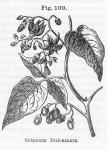
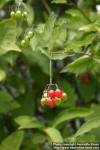 Preparations: Extract of Dulcamara - Fluid Extract of Dulcamara
Preparations: Extract of Dulcamara - Fluid Extract of Dulcamara
Related plant: Solanum Carolinense.—Horse-nettle
"The young branches of Solanum Dulcamara, Linné" (U. S. P.).
Nat. Ord.—Solanaceae.
COMMON NAMES: Bittersweet, Woody night-shade, Violet-bloom, Scarlet-berry.
ILLUSTRATIONS: Bentley and Trimen, Med. Plants, 190; Woodville, Med. Bot., 133.
Botanical Source.—Bittersweet, or Woody night-shade, is a woody vine, having a woody root, with a shrubby, flexuous, thornless, and branching stem, several feet in length; with an ashy-green bark on the stem and large branches. The leaves are alternate, acute, and generally smooth; the lower ones ovate or cordate; the upper ones more or less perfectly hastate, and all entire. The flowers are purple, drooping, and are borne on branching peduncles from the side of the stem, in spreading, cymose clusters. The calyx is very small, purplish, acute, persistent, and 5-parted. The corolla is rotate, purple, with 5 reflexed segments, and 2 round, green spots at the base of each segment. The filaments are short; the anthers erect, opening by pores at the apex, yellow, and converging into a cone. Ovary roundish; style filiform; stigma simple and obtuse. The fruit is a scarlet, oval, juicy, bitter, and poisonous berry, the seeds of which are many, plano-convex, and whitish (L.—W.—G.—B.)
History and Description.—Bittersweet, also known by the names of Violet-bloom and Scarlet-berry, is common to both Europe and this country, growing on moist banks, around dwellings, and in low, damp grounds, about hedges and thickets, flowering in June and July. Its berries are ripened in autumn, and hang upon the vines for several months. The parts used in medicine are the roots and twigs, the latter only being official. The berries when eaten have certainly produced serious consequences, though considered by many to be harmless. The twigs should be collected in the autumn, after the dropping of the foliage; they have an unpleasant odor, which is lost by drying; and their taste is bitter, followed by some sweetness and a slight acridity. The dried twigs found in commerce are in pieces varying in length, having a greenish-gray epidermis, a light wood, and a very light and spongy pith. They impart their properties by infusion to boiling water, and also to diluted alcohol; long boiling impairs their medicinal activity. The U. S. P. describes dulcamara as follows: "About 5 Mm. [1/5 inch] or less thick, cylindrical, somewhat angular, longitudinally striate, more or less warty, usually hollow in the center, cut into short sections. The thin bark is externally pale greenish, or light greenish-brown, marked with alternate leaf-sears, and internally green; the greenish or yellowish wood forms 1 or 2 concentric rings. Odor slight, taste bitter, afterwards sweet"—(U. S. P.).
Chemical Composition.—Two proximate principles have been obtained from Solanum Dulcamara: Solanine, an alkaloidal principle, discovered by Desfosses, in 1820, in the berries of Solanum nigrum, and (1821) in the leaves and stems of S. Dulcamara; and dulcamarin, its bitter-sweet glucosid, was first isolated in pure form by E. Geisler, in 1875. Probably it is identical with a substance previously named picroglycion by Pfaff, and dulcarin by Desfosses (1821). It was again obtained by Biltz (1841), and later by Wittstein, who named it dulcamarin.
Peschier (1828) demonstrated that solanine existed in the berries of dulcamara in even larger quantity than in the leaves and stem; it also occurs in the sprouts of our common potato (see Solanum tuberosum, Related Species) and in various other Solanaceae, e. g., the tomato plant (G. W. Kennedy, Amer. Jour. Pharm., 1873), etc. Desfosses obtained it from the ripe berries of the black night-shade (Solanum nigrum) by expressing the juice, adding ammonia, washing the precipitated alkaloid with cold water, and crystallizing from alcohol, after purifying with animal charcoal. Fresh sprouts of potatoes furnish it in greatest abundance.
Solanine (C43H69NO16, Kraut; C42H87NO15, Hilger) occurs either amorphous, in minute prisms, or in feathery crystals, having a bitter, somewhat acrid taste. Solanine fuses at 235° C. (455° F.). It is soluble in warm amyl alcohol, which abstracts it completely from alkaline solutions; is less soluble in boiling alcohol, still less in cold alcohol, considerably less in ether (1 in 4000), and requires 8000 parts of boiling water for solution. The solution of solanine in alcohol tends to gelatinize upon cooling; the solution in amyl alcohol possesses this property in a pronounced degree (Dragendorff). Solanine has an alkaline reaction and combines with acids to form salts. Dilute mineral acids decompose solanine slowly at ordinary temperatures, and more rapidly at boiling heat, into sugar and solanidine, another alkaloid which is soluble in cold ether and hot alcohol, but hardly soluble in water (Zwenger and Kindt, also Gmelin, 1859). O. Bach (1873) recommends as a test for solanine and solanidine, the behavior of these substances towards a mixture of equal volumes of concentrated sulphuric acid and alcohol; a trace of these alkaloids causes the appearance of a rose-red, then cherry-red color, which lasts for 5 or 6 hours, and is not interfered with by the presence of large quantities of morphine (Amer. Jour. Pharm., 1873).
Dulcamarin (C22H34O10) was obtained by E. Geissler (Archiv. der Pharm., 1875, p. 293) from the stems of dulcamara, by digesting the aqueous infusion with animal charcoal until the peculiar, bitter-sweet taste was removed, washing the charcoal with water and abstracting by means of alcohol. After purification of the bitter-sweet extractive (by using of its lead compound), pure dulcamarin was obtained free from nitrogen (Wittstein's dulcamarin contained nitrogen), as an amorphous yellow substance, possessing the characteristic, bitter-sweet taste of the plant in concentrated form. It is soluble in alcohol and water (30 parts) and in acetic ether, but it is insoluble in ether, chloroform, and -petroleum ether. Diluted sulphuric acid splits it into dulcamaretin, a tasteless, resinous substance, and sugar. Solanine is poisonous.
Action, Medical Uses, and Dosage.—Prof. Caylus, of Leipsic, who has made some careful experiments with solanine, as well as with the twigs of dulcamara, states that an extract of the twigs is from 5 to 10 times more active than the twigs, and solanine is 30 times more powerful than this extract. He considers the plant and its active principles to possess poisonous properties, which may prove fatal in large doses. All these preparations, when administered internally, cause renal congestion, and occasionally an augmented urinary secretion of an albuminous nature; they exert a depressing or paralyzing influence upon the respiratory nervous system, cause increased but enfeebled cardiac action, tetanic spasms of the thoracic muscles as well as those of the extremities, and increase the sensitiveness of the cutaneous nervous system; they exert no direct influence upon the brain, stomach, or bowels. He believes they act more particularly on the spinal cord and medulla oblongata, and recommends the acetate of solanine, in doses of 1/6 to 1 grain, in pulmonary maladies, attended with spasm or irritation (Ann. de Thér., 1859, p. 24).
Solanum Dulcamara is a mild narcotic, diuretic, alterative, diaphoretic, and discutient. In large doses it causes dryness and heat with stinging pain in the fauces, accompanied with thirst, sickness at stomach, vomiting, diarrhoea, prostration or syncope, and spasmodic twitchings. With some persons it depresses the action of the heart and arteries, and causes a moderate degree of lividity on the hands and face. The head usually feels heavy and dizzy, and a cutaneous erythema may be developed. It is reputed antaphrodisiac, and has proved beneficial in mania attended with powerful excitement of the venereal functions. On the other hand, it is said to occasion venereal desires, and to induce heat and itching of the external female parts, attended with strangury.
Dulcamara is a valuable remedy in most acute troubles, brought on by colds, and in chronic skin affections of a pustular, vesicular, or scaly character. It has been chiefly used in syrup or decoction in cutaneous diseases, syphilitic diseases, rheumatic and cachectic affections, ill-conditioned ulcers, scrofula, indurations from milk, leucorrhoea, jaundice, and obstructed menstruation. It is of more benefit in scaly cutaneous diseases than in others, as in leprosy, tetter, eczema, and porrigo, and especially in combination with guaiacum and yellow-dock root.
Dulcamara is a remedy for catarrhal troubles, resulting from cold or suspended cutaneous action. Here the fractional doses should be employed. Suppression of the menses, with headache, nausea, and chilly sensations, when the flow has been arrested by cold, is a case for its exhibition. Dyspnoea, cough, and pain in the chest produced by exposure, are relieved by small doses. Catarrhal headache, from acute colds, and nasal catarrh are both benefited by bitter-sweet, which is also a remedy for retrocession of eruptions, and to primarily develop tardy eruptions. Owing to its kindly action on the stomach and its influence in aiding secretion and excretion, it is a valuable alterative and should have a more general use. In vesical catarrh, aggravated by dampness, it has given good results. The same is true of catarrhal diarrhoea of children, and acute and chronic rheumatism in those who are much exposed or who dwell in cold or damp quarters. Nymphomania and satyriasis were successfully treated with it by Dewees. Pundendal itching and stitching pains have been relieved by it in small doses. Large doses have produced these troubles. Dr. Scudder suggests a trial of the drug in "small doses in those cases of chronic disease in which the circulation is feeble, the hands and feet cold and purplish, with fullness of tissues and tendency to oedema" (Spec. Med., 246). Equal parts of the twigs, yellow-dock root, and stillingia made into a syrup, form a valuable preparation for scrofulous affections, as well as syphilitic. Externally, in the form of ointment, it is employed as a discutient to painful tumors; also as an application to some forms of cutaneous disease, ulcers, and erysipelatous affections. Dose of the decoction or syrup, 1 or 2 fluid ounces; of the extract, from 2 to 5 grains; of the powdered leaves, from 10 to 30 grains; specific dulcamara, fraction of a drop to 30 drops. Small doses act best. The decoction is prepared from 1 ounce of fresh twigs and sufficient water to produce, after boiling for 15 minutes, 1 pint of decoction.
Specific Indications and Uses.—Scaly skin affections; acute disorders due to colds and dampness; deficient capillary circulation in the skin; diminished cutaneous action with urinous odor; coldness and blueness of the extremities; full tissues with tendency to oedema.
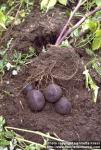 Related Species.—Several other species of Solanum appear to possess medicinal power—among them are: Solanum tuberosum, Linné; Common potato. An extract of the herb, Solanum tuberosum (common potato), has been found useful in chronic rheumatic affections, gastric and intestinal spasm, cough, etc., in the dose of from 1/8 of a grain to 1 grain. Some practitioners have, however, employed it in these affections, and in very large doses, without observing any influence whatever. Probably cultivation, soil, climate, season etc., exert some influence upon the medicinal powers of the plant. The potato itself has been eaten raw, either with or without vinegar, in cases of scurvy, and with good effect; occasionally it has caused narcosis, and slight purgation. Both raw and cooked the potato makes an excellent poultice. Considerable potassium hydroxide may be procured from potato-stalks; and if they be gathered while the plant is in flower, and passed through an oil mill, the juice obtained is said to form a handsome yellow dye. Wackenroder obtained solanine from potato sprouts. The green fruits and the herb of the potato plant have also been shown to contain solanine and its allied bases, solanidine and solaneine. In 1887, Dr. George Kassner demonstrated that weighable quantities of solanine will develop in injured potatoes when stored in a cellar (Amer. Jour. Pharm.). Traces of mydriatic alkaloids (hyoscyamine, etc.) have even been observed in Solanum tuberosum and allied species.
Related Species.—Several other species of Solanum appear to possess medicinal power—among them are: Solanum tuberosum, Linné; Common potato. An extract of the herb, Solanum tuberosum (common potato), has been found useful in chronic rheumatic affections, gastric and intestinal spasm, cough, etc., in the dose of from 1/8 of a grain to 1 grain. Some practitioners have, however, employed it in these affections, and in very large doses, without observing any influence whatever. Probably cultivation, soil, climate, season etc., exert some influence upon the medicinal powers of the plant. The potato itself has been eaten raw, either with or without vinegar, in cases of scurvy, and with good effect; occasionally it has caused narcosis, and slight purgation. Both raw and cooked the potato makes an excellent poultice. Considerable potassium hydroxide may be procured from potato-stalks; and if they be gathered while the plant is in flower, and passed through an oil mill, the juice obtained is said to form a handsome yellow dye. Wackenroder obtained solanine from potato sprouts. The green fruits and the herb of the potato plant have also been shown to contain solanine and its allied bases, solanidine and solaneine. In 1887, Dr. George Kassner demonstrated that weighable quantities of solanine will develop in injured potatoes when stored in a cellar (Amer. Jour. Pharm.). Traces of mydriatic alkaloids (hyoscyamine, etc.) have even been observed in Solanum tuberosum and allied species.
![]() Lycopersicum esculentum, Millspaugh; (Solanum Lycopersicum).—Tomato, or Love-apple, like the potato, came originally from South America. Its fruit contains several acids (citric, oxalic, and malic acids having been shown to be present), a thick, adhesive, brownish, resinous-like substance, and the seeds probably contain an alkaloid. It is much used as an article of food in the United States, and is supposed to exert a healthy influence upon the liver and biliary organs. The leaves have a heavy, disagreeable odor, and contain oil, extractive, and solanine, which has been obtained from all the herbaceous portions of the plant (Kennedy, Amer. Jour. Pharm., 1873). Most of the Solanums are nutritive, or possess medicinal virtues.
Lycopersicum esculentum, Millspaugh; (Solanum Lycopersicum).—Tomato, or Love-apple, like the potato, came originally from South America. Its fruit contains several acids (citric, oxalic, and malic acids having been shown to be present), a thick, adhesive, brownish, resinous-like substance, and the seeds probably contain an alkaloid. It is much used as an article of food in the United States, and is supposed to exert a healthy influence upon the liver and biliary organs. The leaves have a heavy, disagreeable odor, and contain oil, extractive, and solanine, which has been obtained from all the herbaceous portions of the plant (Kennedy, Amer. Jour. Pharm., 1873). Most of the Solanums are nutritive, or possess medicinal virtues.
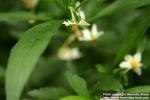 Solanum Pseudo-capsicum, Jerusalem cherry.—A handsome, erect, dwarf tree-like shrub, a native of Mauritius, and bearing large scarlet berries. Poisonous. On account of the resemblance of the fruit to cherries, children are liable to be poisoned by them.
Solanum Pseudo-capsicum, Jerusalem cherry.—A handsome, erect, dwarf tree-like shrub, a native of Mauritius, and bearing large scarlet berries. Poisonous. On account of the resemblance of the fruit to cherries, children are liable to be poisoned by them.
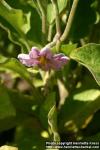 Solanum Melongena (or esculentum), Egg-plant.—Thisplant yields an elongated, purple fruit known as the egg-apple, bimjal, or aubergine. It does not possess the agreeable properties of tomato, but when properly prepared is much esteemed as a vegetable.
Solanum Melongena (or esculentum), Egg-plant.—Thisplant yields an elongated, purple fruit known as the egg-apple, bimjal, or aubergine. It does not possess the agreeable properties of tomato, but when properly prepared is much esteemed as a vegetable.
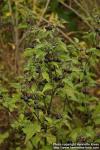 Solanum nigrum, Linné; Garden night-shade, Night-shade.—Solanum nigrum is a fetid, narcotic, bushy herb, with a fibrous root and an erect, branching, angular, herbaceous, thornless stem, 1 or 2 feet in height. Leaves undivided, ovate, toothed, and waved, smooth, lengthened out at the base, almost always with the lamina perforated and the margin erose; as if gnawed by insects. Umbels from the intermediate spaces between the leaves, solitary, peduncled, simple, downy, nodding. Flowers white or pale-violet, with a musky scent; anthers yellow. Berries globose, black, about the size of peas (L.—W.—G.). The Garden, or Black night-shade, is found growing along old walls, fences, and in gardens, in various parts of the United States, flowering in July and August. Another species, the Solanum virginianum, is abundant in this country. It has an erect, prickly stem; pinnatifid leaves, prickly on both sides; divisions sinuate obtuse; margin ciliate; calyx prickly, and flowers blue, or whitish. The leaves of these plants are the parts employed, and yield their properties to water, alcohol, or fixed oils.
Solanum nigrum, Linné; Garden night-shade, Night-shade.—Solanum nigrum is a fetid, narcotic, bushy herb, with a fibrous root and an erect, branching, angular, herbaceous, thornless stem, 1 or 2 feet in height. Leaves undivided, ovate, toothed, and waved, smooth, lengthened out at the base, almost always with the lamina perforated and the margin erose; as if gnawed by insects. Umbels from the intermediate spaces between the leaves, solitary, peduncled, simple, downy, nodding. Flowers white or pale-violet, with a musky scent; anthers yellow. Berries globose, black, about the size of peas (L.—W.—G.). The Garden, or Black night-shade, is found growing along old walls, fences, and in gardens, in various parts of the United States, flowering in July and August. Another species, the Solanum virginianum, is abundant in this country. It has an erect, prickly stem; pinnatifid leaves, prickly on both sides; divisions sinuate obtuse; margin ciliate; calyx prickly, and flowers blue, or whitish. The leaves of these plants are the parts employed, and yield their properties to water, alcohol, or fixed oils.
Solanum nigrum is narcotic and sedative, and produces, when given in large doses, sickness and vertigo. One to 3 grains of the leaves infused in water, will, it is said, produce a copious perspiration, and often purge on the next day. They have been used in cancer, scurvy and scrofulous affections, being applied locally as a cataplasm, or in ointment, and also exhibited in small doses internally. Solanine, which was first obtained from this species by Desfosses, in 1820, exists in it more abundantly than in the S. Dulcamara, to which it is somewhat analogous in medicinal properties, with more active and energetic narcotic virtues. The berries are poisonous, causing torpor, burning in the stomach, fever, nausea, stupor, and insensibility; though this is denied by M. Dunal, of Montpellier. The plant is employed in the form of ointment only, as a discutient.
Solanum paniculatum, Jerubeba.—Brazil. Considerably used by Brazilian physicians in anemia, liver disorders, amenorrhoea, vesical catarrh, and spleen disorders. It is regarded tonic, alterative, antiperiodic, antisyphilitic, antiblennorhagic, and drastic. The leaves, fruit, and root are employed both externally and internally. It is considered a good laxative to overcome chronic constipation. Jerubebine, an alkaloid, is contained in the root and fruit (F. V. Greene, Amer. Jour. Pharm., 1877, p. 506).
Solanum bacciferum.—A variety of this plant yields the toxic susumber berries, from the eating of which several cases of poisoning have been reported. Another variety of the same species is said to be harmless, and its fruit is employed by the natives of Jamaica.
Solanum Jacquinii, Willdenow (Solanum xanthocarpum, Schrader).—A drug of considerable repute in India, where it is valued as a diuretic, expectorant, and sialagogue. It is used in Bengal for dropsy, and, smoked in a pipe, gives relief in toothache. Catarrhal fevers, cough, and asthma are among the conditions said to be benefited by it (Dymock, Mat. Med. Western India).
Lycium umbrosum, Humboldt and Bonpland. Nat. Ord.—Solanaceae. South America. Lycium Afrum, Linné.—North Africa. The leaves of this and the foregoing species are employed in infusion for the relief of numerous skin affections, particularly erysipelas.
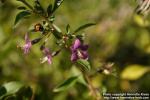 Lycium vulgare, Dunal (Lycium barbarum, Linné); Matrimony vine.—Indigenous to Mediterranean Europe and is found in the United States, both wild and cultivated. Its flowers are of a dull, purple-green hue. The leaves and bark have a sweet, followed by a faintly bitter, acrid taste. Lycine (C5H11NO2), in deliquescent, white, prismatic crystals, was obtained by Husemann and Marmé, in 1863, from the leaves and branches, the former yielding the larger amount of alkaloid. Its identity with Scheibler's betaïne (Liebrich's oxyneurine), from the juice of beet-root, was subsequently (Archiv. der Pharm., 1875, p. 216) proven by Husemann. According to the latter, it does not pre-exist in the plant, but is developed during the process of obtaining it—i. e., heating in the presence of hydrochloric acid. Alkaloidal mydriatic principles, like those from belladonna, have been detected in this plant by E. Schmidt and others (see Amer. Jour. Pharm., 1890, pp. 13 and 492).
Lycium vulgare, Dunal (Lycium barbarum, Linné); Matrimony vine.—Indigenous to Mediterranean Europe and is found in the United States, both wild and cultivated. Its flowers are of a dull, purple-green hue. The leaves and bark have a sweet, followed by a faintly bitter, acrid taste. Lycine (C5H11NO2), in deliquescent, white, prismatic crystals, was obtained by Husemann and Marmé, in 1863, from the leaves and branches, the former yielding the larger amount of alkaloid. Its identity with Scheibler's betaïne (Liebrich's oxyneurine), from the juice of beet-root, was subsequently (Archiv. der Pharm., 1875, p. 216) proven by Husemann. According to the latter, it does not pre-exist in the plant, but is developed during the process of obtaining it—i. e., heating in the presence of hydrochloric acid. Alkaloidal mydriatic principles, like those from belladonna, have been detected in this plant by E. Schmidt and others (see Amer. Jour. Pharm., 1890, pp. 13 and 492).

